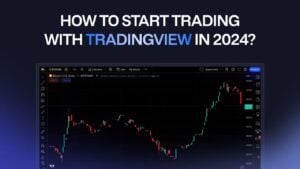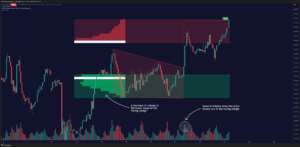As a long-time trader and analyst, I’ve navigated these waters for over two decades. As such, I have used both relative strength index (RSI) and stochastic oscillator for a long time. To be clear, I didn’t witness their inception; I am not THAT old.
While RSI is a well-known tool, its Stochastic extension often remains underutilized and misunderstood. A stochastic RSI is derived by applying the stochastic oscillator formula (another well-known indicator) to a set of RSI values.
In this article, we’ll dive into what RSI and Stochastic RSI are, how they differ, and, most importantly, how you, as a trader, can use them to their fullest potential.
Relative Strength Index (RSI) and Stochastic Oscillator
1. What is the RSI indicator?
The Relative Strength Index (RSI) is a momentum oscillator that helps identify overbought and oversold conditions in the market. Created by J. Welles Wilder Jr. in 1978, it’s integral to many trading strategies.
Formula:
RSI = 100 – 1001 + RS
, where RS (Relative Strength) = (Average Gain over n periods) / (Average Loss over n periods).
Calculation: The RSI is calculated using average price gains and losses over a chosen period, usually 14 days.
Interpretation: An RSI above 70 indicates an overbought market in a bullish market. You could face a pullback if you don’t sell. Conversely, an RSI reading below 30 in a bearish market can suggest that the stock might be oversold, potentially leading to a rebound.
2. What is the Stochastic Oscillator indicator?
The Stochastic Oscillator is a momentum indicator that compares a particular closing price of a security to a range of its prices over a certain period.
Developed by George C. Lane in the late 1950s, it’s a tool used to predict price turning points by comparing the closing price to its price range.
Stochastic Oscillator uses two trend lines, here are the formulas:
- %K = (Current Close – Lowest Low) / (Highest High – Lowest Low) × 100.
- %D line is typically used as a signal or trigger line, calculated as a simple moving average of %K.
The Stochastic Oscillator ranges between 0 and 100.
If a stock’s Stochastic Oscillator rises above 80 in a trading scenario, it might signal that it is potentially overvalued and could see a price pullback. Conversely, a reading below 20 could indicate a potential undervaluation, suggesting a price increase.
What is the Stochastic RSI indicator?
Stochastic RSI, often termed StochRSI, is a derivative of the traditional RSI and stochastic oscillator, designed to offer more sensitivity and generate more frequent signals.
It’s like taking the RSI for a turbocharged spin. This indicator oscillates between 0 and 1 (or 0 to 100 sometimes), designed to identify more precise overbought and oversold levels.
Differences in Calculation
While RSI and StochRSI may share a common lineage, their calculations set them apart. Traditional RSI focuses on average gains and losses over a specific period to determine the velocity of price movements.
StochRSI Calculation:
– StochRSI = (RSI – Lowest Low RSI) / (Highest High RSI – Lowest Low RSI).
– This formula essentially measures the level of the RSI relative to its high-low range over a set period.
Advantages of Using Stochastic RSI
StochRSI has several advantages, making it a unique tool in a trader’s arsenal.
1. Increased Sensitivity: StochRSI moves faster than the traditional RSI, often leading to earlier signals. This can be a boon in fast-paced markets where catching trends early is key.
2. Refined Overbought/Oversold Levels: StochRSI can pinpoint overbought and oversold conditions more precisely than traditional RSI, helping traders make more informed decisions.
3. Flexibility: The StochRSI can be adjusted for different time frames, making it versatile for various trading styles, from day trading to long-term investments.
Which is Better, RSI or Stochastic RSI?
The Stochastic RSI considers closing prices plus highs and lows in a recent range for calculation. At the same time, the RSI oscillator considers only the closing price of a recent period.
| Indicator | RSI | Stochastic RSI |
|---|---|---|
| Appearance on Chart | Single line fluctuating between 0-100 | Two lines (%K and %D) fluctuate between 0-1 (or 0-100) |
| Settings | Period of 14 (standard) | Typically 14 for RSI period, %K and %D lines usually set to 3 |
| Ideal Market Conditions | Best in range-bound markets | Performs well in trending markets |
| Overbought/Oversold Conditions in a Ranging Market | More reliable in indicating potential reversals within the range | Can provide multiple signals, advantageous for short-term trading but may lead to false positives |
| Overbought/Oversold Conditions in a Trending Market | Can remain overbought or oversold for long periods, less effective for spotting reversals | More responsive, providing quicker signals but can lead to false positives |
| Common Use Cases | Identifying potential reversals within a range | Providing early signals in trending scenarios |
| Crossovers | Used with a smoothed moving average; crossover can indicate a change in trend | The %K line crossing above or below the %D line provides frequent trading signals |
| Divergence | Less frequent but stronger signals | More frequent divergences due to increased sensitivity |
| Sensitivity | Moderate, less prone to noise | High can lead to more false signals in non-trending markets |
| Best For | Traders looking for simplicity and reliability | Traders who prefer quick responsiveness and detailed analysis |
Performance Comparison in Trending Markets
RSI: In a strong trending market, RSI can sometimes remain overbought or oversold for extended periods, making it less effective for spotting reversals.
Stochastic RSI: This indicator tends to fluctuate more rapidly, providing quicker signals that can be advantageous in a trending market. It’s more responsive to immediate price changes, offering potentially earlier signals for entry and exit.
Performance Comparison in Trending Markets Sideways Markets
RSI: RSI shines in sideways markets, where its readings are more reliable. For instance, in a range-bound market, an RSI reading near 70 or 30 can indicate potential reversals within the range.
Stochastic RSI: Due to its sensitivity, It might generate more false signals in a sideways market, making it challenging for traders to discern the noise from true market signals.
Expert Opinions
In the trading community, opinions vary. Some seasoned traders swear by the traditional RSI for its simplicity and reliability, especially in range-bound markets. Others prefer the Stochastic RSI for its quick responsiveness in trending scenarios.
Studies have shown that neither indicator consistently outperforms the other across all market conditions. Instead, the key lies in understanding the current market environment and selecting the best indicator with those conditions.
As for my take, I’ve found that combining the insights from RSI and Stochastic RSI can provide a more rounded view of the market. Using them in tandem has often led to more informed and confident decision-making in my trading career.
How do you use stochastic RSI?
Step 1: Understanding the Basics
Stochastic RSI is an oscillator that sometimes varies between 0 and 1 (or 0 to 100), indicating overbought and oversold conditions.
Step 2: Calculating Stochastic RSI
First, calculate the RSI of the security. Then, Stochastic RSI = (Current RSI – Lowest RSI) / (Highest RSI – Lowest RSI).
Step 3: Interpreting the Readings
– Readings above 0.8 (or 80) typically indicate overbought conditions, signaling potential selling opportunities.
– Readings below 0.2 (or 20) suggest oversold conditions, potentially indicating buying opportunities.
Tip: Don’t be daunted by the formula. Many trading platforms offer Stochastic RSI as a standard tool, automating these calculations.
What are the best strategies for StochRSI?
1. Trend Confirmation Strategy: Use Stochastic RSI with trend indicators like moving averages. It might be a good time to buy if the trend increases and the Stochastic RSI moves above 0.2 (or 20).
2. Divergence Trading: Look for discrepancies between the Stochastic RSI and price movements. For instance, if the price hits a new high but Stochastic RSI doesn’t, it might signal a potential reversal.
3. Overbought/Oversold Crossovers: Buy when the Stochastic RSI crosses above 0.2 (or 20) in an uptrend, and consider selling when it crosses below 0.8 (or 80) in a downtrend.
Tips on Avoiding Common Errors:
– Avoid relying solely on Stochastic RSI; always confirm signals with other indicators or analysis.
– Be cautious of false signals in sideways markets.
– Remember that in strong trends, Stochastic RSI can remain in overbought/oversold zones for extended periods.
What is the Best Setting for Stochastic RSI?
The best setting for Stochastic RSI typically involves a 14-period time frame with %K and %D lines set to 3. This setting balances sensitivity and reliability for most markets. The 14-period setting provides a good balance between short-term sensitivity and longer-term trend analysis.
Tip: Adjusting the %K and %D lines can fine-tune the indicator’s responsiveness.
What is the Best Time Frame for Stochastic RSI?
The best time frame for Stochastic RSI varies depending on the trader’s style. Day traders might prefer shorter time frames, like 5 or 15 minutes, while swing traders may opt for daily or weekly charts.
– Shorter time frames can provide more signals and increase the risk of false positives.
– Longer time frames offer fewer but potentially more reliable signals.
What are the 2 Lines in Stochastic RSI?
%K Line:
In Stochastic RSI, ‘K’ refers to the %K line, which represents the current value of the Stochastic RSI, often used to identify overbought or oversold conditions.
The %K line is calculated based on recent closing prices and their relation to the high-low range.
%D Line:
%D line is a moving average of the %K line. The %K line reacts quickly to market changes, while the %D line smooths out the %K’s volatility.
Tip: Crossovers between these two lines can signal potential trading opportunities.
What is the best indicator with stochastic RSI?
Determining the “”best”” indicator to pair with Stochastic RSI hinges on your trading strategy and goals.
That said, Pairing Stochastic RSI with a trend-following indicator, such as the Moving Average Convergence Divergence (MACD), is one of the most profitable combinations due to the sensitivity and responsiveness of this pair.
Here are some examples of successful strategies:
1. Stochastic RSI with Moving Averages
Use a simple moving average (SMA) or exponential moving average (EMA) to determine the trend. Apply Stochastic RSI to identify potential entry points in the direction of the trend.
2. Stochastic RSI and Bollinger Bands
Bollinger Bands can help identify the volatility and trend. Stochastic RSI can then pinpoint overbought or oversold conditions within these bands, signaling potential reversals or continuations.
Here’s an example of a trading strategy:
In a rising market, wait for the price to touch the lower Bollinger Band. Look for the Stochastic RSI to move into the oversold region and start climbing out.
This combination often signals a strong buy opportunity, as per my trading experiences.
3. Stochastic RSI with MACD
Here are two strategies that you can use when pairing StochRSI with MACD.
Trend Identification with MACD:
First, use MACD to establish the overall trend direction. A positive MACD indicates an uptrend, while a negative MACD suggests a downtrend.
Refined Entry/Exit Points with Stochastic RSI:
Once the trend is identified, utilize Stochastic RSI to find optimal entry and exit points. For example, look for Stochastic RSI to dip into the oversold area in an uptrend and then move back above it as a potential buy signal.






